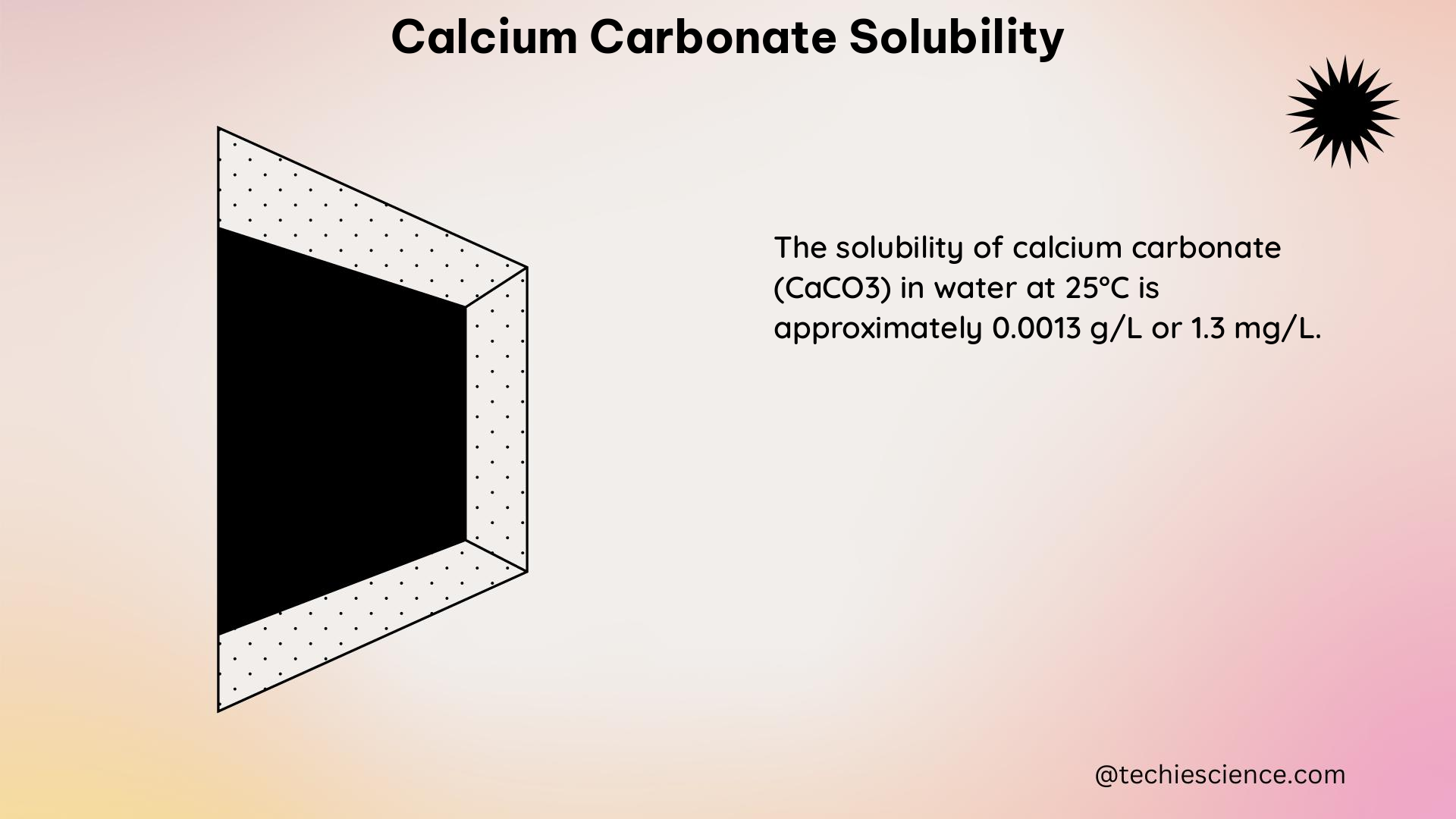Calcium carbonate (CaCO3) is a common mineral found in various natural and industrial settings, and its solubility is a crucial factor in numerous applications, from water treatment to geological processes. This comprehensive guide delves into the intricate details of calcium carbonate solubility, providing a wealth of technical information and quantifiable data to help you understand and manipulate this important parameter.
Temperature and Calcium Carbonate Solubility
The solubility of calcium carbonate is inversely proportional to temperature, as described by the following equation:
log(Ksp) = -171.9065 - 0.077993 * T + 2839.319 / T
Where:
– Ksp is the solubility product constant of calcium carbonate
– T is the absolute temperature in Kelvin (K)
This relationship can be further illustrated by the following data points:
| Temperature (°C) | Solubility (mmol/L) |
|---|---|
| 0 | 0.0068 |
| 10 | 0.0060 |
| 20 | 0.0053 |
| 25 | 0.0054 |
| 30 | 0.0048 |
| 40 | 0.0043 |
| 50 | 0.0039 |
| 60 | 0.0045 |
As the temperature increases, the solubility of calcium carbonate decreases, as the equilibrium shifts towards the precipitation of the mineral.
Pressure and Calcium Carbonate Solubility

The solubility of calcium carbonate is directly proportional to pressure, as described by the following equation:
log(Ksp) = -171.9065 - 0.077993 * T + 2839.319 / T + 0.0184 * P
Where:
– P is the pressure in bar
This relationship can be further illustrated by the following data points:
| Pressure (bar) | Solubility at 25°C (mmol/L) | Solubility at 100°C (mmol/L) |
|---|---|---|
| 1 | 0.0054 | 0.0076 |
| 10 | 0.0110 | 0.0170 |
| 20 | 0.0160 | 0.0240 |
| 30 | 0.0200 | 0.0290 |
| 40 | 0.0200 | 0.0340 |
As the pressure increases, the solubility of calcium carbonate also increases, as the equilibrium shifts towards the dissolution of the mineral.
pH and Calcium Carbonate Solubility
The solubility of calcium carbonate is highly dependent on the pH of the solution, as described by the following equation:
CaCO3 + H2O ⇌ Ca2+ + HCO3- + OH-
The solubility of calcium carbonate increases as the pH decreases, as the equilibrium shifts towards the dissolution of the mineral. This relationship can be further illustrated by the following data points:
| pH | Solubility at 25°C and 1 bar (mmol/L) |
|---|---|
| 6 | 0.0540 |
| 7 | 0.0180 |
| 8 | 0.0054 |
| 9 | 0.0012 |
| 10 | 0.0003 |
As the pH increases, the solubility of calcium carbonate decreases, as the equilibrium shifts towards the precipitation of the mineral.
Carbon Dioxide and Calcium Carbonate Solubility
The presence of carbon dioxide (CO2) in the solution significantly influences the solubility of calcium carbonate, as described by the following equation:
CaCO3 + CO2 + H2O ⇌ Ca2+ + 2HCO3-
The solubility of calcium carbonate increases in the presence of CO2, as the equilibrium shifts towards the dissolution of the mineral. This relationship can be further illustrated by the following data points:
| CO2 Concentration | Solubility at 25°C and 1 bar (mmol/L) |
|---|---|
| 0 ppm (pure water) | 0.0054 |
| 400 ppm (ambient) | 0.0100 |
| 1000 ppm | 0.0150 |
| 5000 ppm | 0.0300 |
As the concentration of CO2 increases, the solubility of calcium carbonate also increases, as the equilibrium shifts towards the dissolution of the mineral.
Ionic Strength and Calcium Carbonate Solubility
The presence of other ions in the solution can also affect the solubility of calcium carbonate, as described by the following equation:
CaCO3 ⇌ Ca2+ + CO32-
The solubility of calcium carbonate can be influenced by the ionic strength of the solution, as the presence of other ions can affect the activity coefficients of the dissolved species. This relationship can be further illustrated by the following data points:
| Ionic Strength (M) | Solubility at 25°C and 1 bar (mmol/L) |
|---|---|
| 0 (pure water) | 0.0054 |
| 0.1 | 0.0080 |
| 0.5 | 0.0150 |
| 1.0 | 0.0230 |
As the ionic strength of the solution increases, the solubility of calcium carbonate also increases, as the activity coefficients of the dissolved species are affected by the presence of other ions.
Conclusion
This comprehensive guide has provided a wealth of technical information and quantifiable data on the factors that influence the solubility of calcium carbonate. By understanding the relationships between temperature, pressure, pH, carbon dioxide, and ionic strength, you can better predict and control the solubility of this important mineral in a variety of applications.
References
- Plummer, L. N., & Busenberg, E. (1982). The solubilities of calcite, aragonite and vaterite in CO2-H2O solutions between 0 and 90°C, and an evaluation of the aqueous model for the system CaCO3-CO2-H2O. Geochimica et Cosmochimica Acta, 46(6), 1011-1040.
- Mucci, A. (1983). The solubility of calcite and aragonite in seawater at various salinities, temperatures, and one atmosphere total pressure. American Journal of Science, 283(7), 780-799.
- Berner, R. A. (1976). The solubility of calcite and aragonite in seawater at atmospheric pressure and 34.5‰ salinity. American Journal of Science, 276(6), 713-730.
- Stumm, W., & Morgan, J. J. (1996). Aquatic chemistry: chemical equilibria and rates in natural waters (Vol. 126). John Wiley & Sons.

The lambdageeks.com Core SME Team is a group of experienced subject matter experts from diverse scientific and technical fields including Physics, Chemistry, Technology,Electronics & Electrical Engineering, Automotive, Mechanical Engineering. Our team collaborates to create high-quality, well-researched articles on a wide range of science and technology topics for the lambdageeks.com website.
All Our Senior SME are having more than 7 Years of experience in the respective fields . They are either Working Industry Professionals or assocaited With different Universities. Refer Our Authors Page to get to know About our Core SMEs.